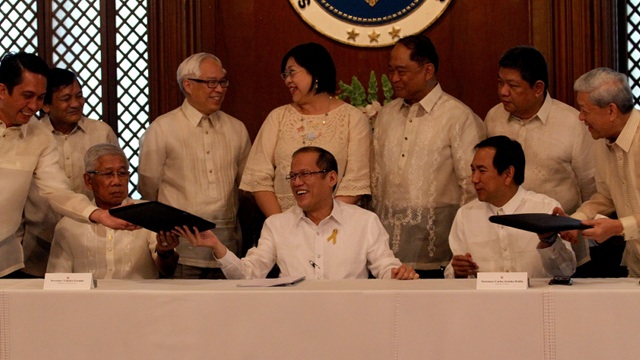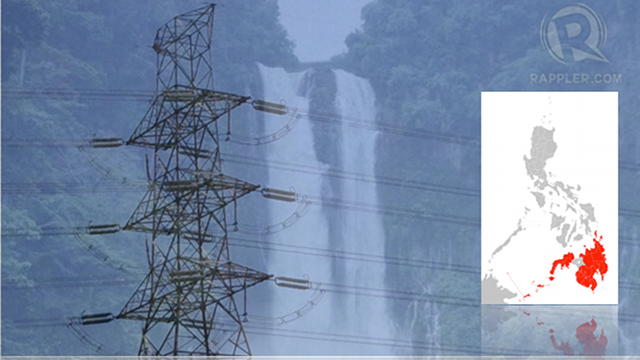SUMMARY
This is AI generated summarization, which may have errors. For context, always refer to the full article.

MANILA, Philippines – The power crisis that is plaguing Mindanao is a consequence of the sins of the region’s past leaders, President Benigno Aquino III said.
In a speech on Wednesday, April 17, he cited how the legislators from Mindanao pursued “temporary convenience [that] trumped preparedness for the future.”
“As you may know, the energy situation in Mindanao did not arise overnight. Trouble began brewing when — and I am sorry to say this — a number of legislators from the region, and other leaders, wished to be exempted from the Electric Power Industry Reform Act of 2001 (Epira),” he said during a contract signing between state-owned industrial park Phividec and Filinvest Development Utilities, Inc.
“This divorced Mindanao from the Republic Act that allowed Napocor (former state power monopoly National Power Corp.) to sell its plants to private investors, using the proceeds to reduce its debt,” he stressed.
Epira was meant to restructure and privatize what was then an inefficient and state-owned power industry, and increase competition, with the end goal of bringing power rates down.
Cheap power
Aquino pointed out that the efforts done then by the leaders of Mindanao — which sources about half of its power supply from cheap hydro-based resources — neglected basic market and economic realities.
“Back then, leaders from Mindanao sought to continue taking advantage of the massive hydro resources in the area, with, unfortunately, the dangerous assumption that the cheap hydro power could last forever. They neglected the fact that the hydropower plants are machines that need to be maintained, improved, and if not replaced, especially if they are to meet the increasing demand,” he said.
“Instead of actively protecting the source of hydropower, illegal logging was allowed to continue, watersheds were lost, which, compounded with the effects of climate change, significantly limited the amount of power that could be produced,” he noted.
“This focus on maintaining cheap power in an unsustainable manner also scared away investors, who did not have the confidence to set up alternative power resources in Mindanao,” he added.
This was a sentiment shared by the Aboitiz group in an investment briefing in February. Erramon Aboitiz, president and CEO of Aboitiz Equity Ventures, had cited Napocor, the operator of the Agus-Pulangi hydropower complex, as the reason why the group, one of the biggest power players in the Philippines, held back in investing in Mindanao decades ago.
With the water that flows from the Lanao lake and Agus river system, the power plant offered the lowest rates in the country.

Analysis paralysis
Blaming the past and not acting fast enough based on the symptoms of a looming power problem is a common analysis among Mindanao watchers.
In an April 11 forum, economist Gerardo Sicat said the power crisis is happening because “the government failed to pursue the series of long-term actions required to solve the power development problems of Mindanao.”
In a research paper, Sicat blamed the power crisis on the following factors:
- Mindanao’s electricity distribution grid was not connected to the grids of Luzon and Visayas.
- The base load of power generation for the region was not increased sufficiently.
- “Snail-paced” decision-making for undertaking approvals
- Privatization of government power plants through the Electric Power Industry Reform Act did not push through
“The signs had been known by all concerned for years, especially by the national government. Inaction on the required policy front meant that the day of reckoning would simply arrive and blow up the picture. That has now become a reality. Government inaction to do the right thing was due to a paralysis of decision-making,” he said.
President Aquino inherited the problem when he took over in 2010.
Power projects
Aquino said that with all the power projects in the pipeline for Mindanao, he expects the power shortage to be over by 2015. He cited two coal-fired power plants from Aboitiz scheduled for completion in late 2015. The plants, which are located in Davao, will provide a total of 300 megawatts. The 3 plants from Filinvest, on the other hand, are expected to provide a total of 405 megawatts.
“With the energy these plants will be producing, by 2016, we expect production capacity to be almost 470 megawatts above peak demand. Nakakataba po ng puso ‘pag nangyari na nga po ‘to, kaysa ngayon na four megawatts above demand ‘pag sinuwerte (This would make me happy if this happens, unlike now where we get four megawatts above demand if we’re lucky).
The Mindanao’s power crisis has caused power outages that average 8 hours per day. This is due to a power shortfall of 294 megawatts (MW).
The region’s actual supply is only at 863 MW, which is not enough to cover demand at 1,157 MW
Phividec and Filinvest signed a 28-year lease agreement for 84.4 hectares of land in Villanueva, Misamis Oriental. Filinvest will construct a coal-fired power generation facility worth P29-P30 billion. – Rappler.com
Add a comment
How does this make you feel?
![[ANALYSIS] A new advocacy in race to financial literacy](https://www.rappler.com/tachyon/2024/04/advocacy-race-financial-literacy-April-19-2024.jpg?resize=257%2C257&crop_strategy=attention)


![[In This Economy] Can the PH become an upper-middle income country within this lifetime?](https://www.rappler.com/tachyon/2024/04/tl-ph-upper-income-country-04052024.jpg?resize=257%2C257&crop=295px%2C0px%2C720px%2C720px)

There are no comments yet. Add your comment to start the conversation.